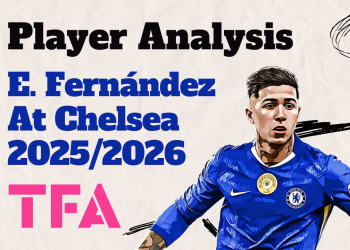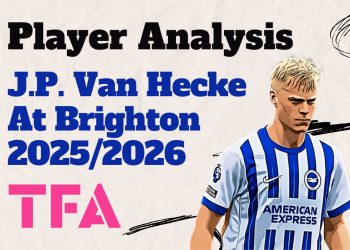After dropping points against Newcastle, Manchester City received some help from West Ham United. The 1-1 draw between Pellegrini’s men and Liverpool was a wave of relief to Pep Guardiola, who saw his chances of a second consecutive Premier League title stay intact. Everton, had who lost four of the five last games, wanted to keep their chances of reaching a Europa League spot.
In this tactical analysis we see how each team changed their tactical approach compared to their last encounter in December 2018, but a goal in added time of each half gave the three points to Manchester City.
First half: High intensity, but not many chances
If there is one word to define the first half of the game, it is intensity. It was not the most beautiful game with few chances for either team, but the intensity level was very high. Both teams played a very vertical game, with direct passing and fervent pressure. This resulted in a high number of turnovers in possession and a good amount of time spent in the middle third of the pitch.
Last time they met it was a strange game. A relatively easy win for Manchester City contained few but very clear chances generated by Everton, although most of the game was spent with Manchester City in possession and Everton on the back foot. Both teams tried to adapt from that last game, with Guardiola deploying the classic 4-3-3 but with Bernardo Silva on the right wing.
The Portuguese gets much more involved in the build-up phase, moving back to connect with the midfielders. Therefore, Guardiola must have expected a similar defensive positioning by Everton, that needed more players in the middle to have numerical superiority to break Everton’s two defensive lines.





![RB Leipzig Vs Bayer Leverkusen [1–3] – Bundesliga 2025/2026: How Kasper Hjulmand Tactics Won Out – Tactical Analysis 3 RB Leipzig Vs Bayer Leverkusen Bundesliga 20252026](https://totalfootballanalysis.com/wp-content/uploads/2025/12/RB-Leipzig-Vs-Bayer-Leverkusen-Bundesliga-20252026-1-350x250.png)

![Napoli Vs AC Milan [2–0] – Supercoppa Italiana 2025/2026: How Antonio Conte Tactics Punished Rossoneri Errors – Tactical Analysis 5 Napoli Vs AC Milan 20252026 - tactical analysis](https://totalfootballanalysis.com/wp-content/uploads/2025/12/Napoli-Vs-AC-Milan-20252026-tactical-analysis-1-350x250.png)


![Manchester United Vs Bournemouth [4–4] – Premier League 2025/2026: Why Are Rúben Amorim Tactics Exposed In Transition? – Tactical Analysis 8 Manchester United vs Bournemouth 20252026 - tactical analysis](https://totalfootballanalysis.com/wp-content/uploads/2025/12/Manchester-United-vs-Bournemouth-20252026-tactical-analysis-1-350x250.png)
